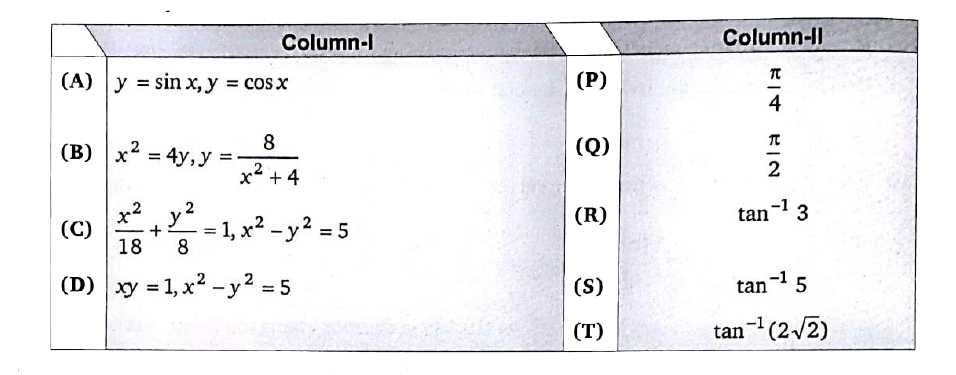Let a,b,c and d be non-negative real number such that a5+b5≤1andc5+d5≤1. Find the maximum value of a2c3+b2d3.
The correct Answer is:1
Step by step video, text & image solution for Let a,b,c and d be non-negative real number such that a ^(5)+b^(5) le 1 and c ^(5) + d^(5) le 1. Find the maximum value of a ^(2) c ^(3) +b^(2) d ^(3). by Maths experts to help you in doubts & scoring excellent marks in Class 12 exams.
Updated on:21/07/2023Topper's Solved these Questions
Similar Questions
Column-1 gives pair of curves and column-II gives the angle θ between the curves at their intersection point.

View SolutionLet f be a differentiable function satisfying the condition f(xy)=(fx))f(y)(y≠0,f(y)≠0)∀x,y∈Randf'(1)=2. If the smaller area enclosed by y=f(x),x2+y2=2 is A, then findal [A], where [.] represents the greatest integer function.
View SolutionIf a+1=b+2=c+3=d+4=a+b+c+d+5, then (a+b+c+d) is equal to
View SolutionIf A=(2351),B=(abcd) and AB = -13I, then find the value of a + b - c + d.
(a) 5 (b) 3 (c) 2 (d) 1
View SolutionIf (1001)(ab+cb−cd)=(4−532), then (a-b) + (c-d)=____.
View SolutionLet a,b,c and d be non-negative real number such that a5+b5≤1andc5+d5≤1. Find the maximum value of a2c3+b2d3.
View SolutionThe ratio of A : B = 1 : 3,B: C= 2:5 and C : D = 2:3 . Find the value of A:B:C:D
View SolutionFind the number of quadruplets of positive integers (a,b,c,d) satisfying the following relations . 1≤a≤b≤c≤dandab+cd=a+b+c+d+3
View SolutionLet a,b,c and d be non-negative real number such that a5+b5≤1andc5+d5≤1. Find the maximum value of a2c3+b2d3.
View SolutionMatch the Column I and Column II and pick the correct matching from the codes, given below:
'(##VPU_HSS_CHE_XI_C14_E05_010_Q01##)'
(a) A-3,B-4,C-1,D-5,E-2
(b) A-1,B-2,C-3,D-4,E-5
(c) A-3,B-5,C-1,D-2,E-4
(d)A-5,B-3,C-1,D-2,E-4
(e)A-2,B-3,C-5,D-4,E-1
View SolutionFind the number of quadruplets of positive integers (a,b,c,d) satisfying the following relations . 1≤a≤b≤c≤dandab+cd=a+b+c+d+3
View SolutionMatch the following and choose the correct combination from the options given : (a) {:(A, B, C, D),(3 , 1, 5, 4):} (b) {:(A, B, C, D),(1, 2, 3, 4):} (c) {:(A, B, C, D),(2, 1, 3, 4):} (d) {:(A, B, C, D),(3, 1, 5, 2):}
View SolutionGiven A = {2,4,5 }, B = {2, 5}, C = {3, 4} and D = {1, 3, 5} , check if (A ∩ C) × (B ∩ D) = (A × B) ∩ (C × D) is true?
View Solutionmatch the columns

(a) a -4, b-2,c-5,d-1
(b) a-4,b-5,c-2,d-1
(c) a-4,b-5,c-1,d-2
(d) a-5, b-4,c-1,d-2
View SolutionIf A:B=1:2,B:C=3:4andC:D=5:6 find D: C : B :A
View SolutionIf A : B = 5 : 2, B : C = 2 : 3 and C: D = 5: 3 , then the ratio A: B : C : D is
View Solution

